|
FSE 38/58 New Squelch Addition 3-14
|
Overview: This addition of a small tone board enables the FSE 38 to key or trigger the "new squelch" systems in several variety of military radios. The new squelch uses a 150 cycle standard. The addiction of this tone board requires at the most, soldering 2 connections and a ground wire and possibly adding one resistor and adjusting a variable pot on the installed board for tone output. This installation will provide a "encode code" only. Decode is not used as the FSE 38/58 has standard squelch on the receiver.
PL Back Ground : PL has been used for many years by the commercial two
way radio industry. It allows several users to occupy the same frequency
and only hear the transmission that have their own individual tone or
PL, so they would not hear the other users. In theory you were supposed
to monitor or open up your base station or mobile receiver receiver prior
to transmitting but in practice it was seldom done, thus a lot of interference
was created when users would "step on" each other. The army
adapted this scheme in hopes of quieting the receiver and avoiding
static bursts etc. But using the new squelch puts the radio in a non-
compatible class with our older equipment and other NATO nations. . Also
jamming could go undetected because the radio operator was on "new
squelch" and could the jamming.
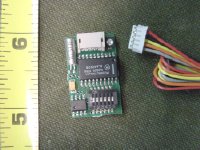 I
selected the Communications specialist (Comm Spec) board SS-64, it measures
.66 inches by 1.08 inches.and has an adjustable output up to 2 volts. Its
is small and runs off of +6 to 28 volts.
I
selected the Communications specialist (Comm Spec) board SS-64, it measures
.66 inches by 1.08 inches.and has an adjustable output up to 2 volts. Its
is small and runs off of +6 to 28 volts.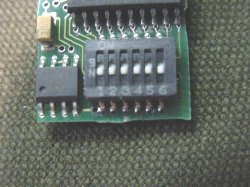
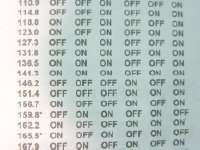
The tone frequency is selected by
dip switches. The nearest frequency on the chart is 151.4 cycles, I know
that a lot of folks will complain about his being off by 1.4 cycles from
the desired frequency of 150, but for close range work , this will work,
try it you'll will like it. Another option is the Ramsey TD1 which
is a kit and is continuously tunable but most of you do not have the test
equipment to set this on 150 cycles and you wind up being a few cycles
off frequency anyway so what's the diff? We come full circle and wind
up being several cycles off or 1.4 cycles. .
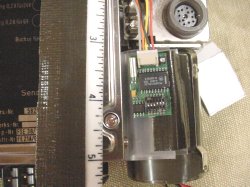 I
installed the board in a clear plastic flat envelope fabracated from a document
protector on the "Sender"side of the radio in the area of the
battery case,the plastic holder is held in place by Olive Drab duct tape(what
else).The board is shipped with 3 M double stick tape for mounting.
I
installed the board in a clear plastic flat envelope fabracated from a document
protector on the "Sender"side of the radio in the area of the
battery case,the plastic holder is held in place by Olive Drab duct tape(what
else).The board is shipped with 3 M double stick tape for mounting.You can view the details of encoder at Comm-Spec.Com.
The Comm - Spec sheet give a quick start checklist.
1. Red wire to +volts
2. Black wire to ground(on the FSE it is the chassis)
3.Yellow wire to modulator
4.Orange and gray wires are unused.
5. Make sure that the jumper JP-1 is in,(it is shipped this way)
6.Set Modulation level with the variable pot(tool included)
( Make sure that you have the dip switches selected for proper tone.)
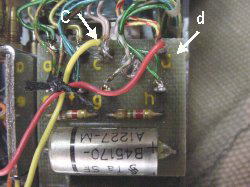 You
may have to add a series resistor in series with the yellow audio lead
to prevent loading down the normal microphone audio circuit, start out
with 10K to 50 K ohms, but on my radio this was not necessary.
You
may have to add a series resistor in series with the yellow audio lead
to prevent loading down the normal microphone audio circuit, start out
with 10K to 50 K ohms, but on my radio this was not necessary.
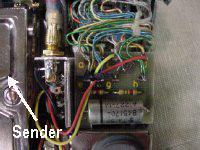
The yellow audio output wire goes to pin c, the Red power wire goes to
pin d
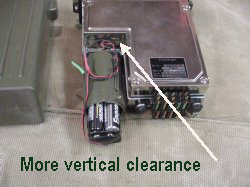 You
may find that you have more room on the empfanger side of the radio in the
battery case area.
You
may find that you have more room on the empfanger side of the radio in the
battery case area. I
have not personally built the Ramsey kit but offer it here as an alternative.It
appears that the two large caps may have to be mounted sideways in order
to have vertical clearance in the FSE 38, this would make the board a
little wider. The Ramsey kit uses a continuously tunable muti-turn resistor
to vary the tone frequency so it is possible to get it very close to 150
cycles. You can paint the board flat black or forest green to match the
radio.
I am not connected with Comm Spec however I do like their products,
their warranty programs, and technical support. I did write a product
review of the ID-8 Identifier/Timer for one of the ham magazines.(Hint:
the editor's name is a color) The article can be seen at seen at:
Comm-Spec web site.